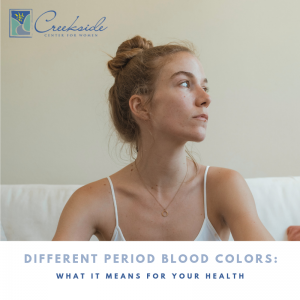What Does Your Period Blood Color Mean
 When you have your period, your uterus sheds its lining. Menstrual blood flows from the uterus through the cervix and passes out of the body through the vagina. Through the duration of your period, the blood might change color, ranging from black to orange to pink to deep red. Different colors of period blood have different significance for your health. Here's a guide to determine what they could mean for your health.
When you have your period, your uterus sheds its lining. Menstrual blood flows from the uterus through the cervix and passes out of the body through the vagina. Through the duration of your period, the blood might change color, ranging from black to orange to pink to deep red. Different colors of period blood have different significance for your health. Here's a guide to determine what they could mean for your health.
Period Blood Color
If you have noticed different colors in your period blood, it's usually normal. In most cases, the color change relates to how long the blood has been in the uterus. Your flow will change how long the blood remains in your uterus. You may see bright red blood on your heaviest days and brown blood on your lightest days.
However, certain colors can signal a problem, and you'll want to see your healthcare provider. If you see a color that's unfamiliar or gray, make an appointment to get checked out. Also, any bleeding during pregnancy is a reason to contact your doctor.
Black or Brown Blood
Black or brown blood might look alarming, but it isn't necessarily a reason to worry. This color may look like coffee grounds. Black or brown is usually old blood, which has had time to oxidize, changing the hue.
Brown blood, in particular, is often seen at the start or end of your period. At these times, your flow may be slow, which slows down the process of the blood leaving the uterus. The blood may also be left over from your last period.
Dark Red Blood
You may see dark red blood upon waking during your period or after you've been lying down for a while. The deep color may merely mean that the blood has been in the uterus for a while but hasn't oxidized yet.
Dark red blood is associated with the end of your period. You may also see this color blood toward the end of your normal menstrual period as your flow slows.
Bright Red Blood
Your period may start with bright red bleeding as the blood is fresh and is flowing quickly. Your blood may stay this way your whole period or may darken as your flow slows.
After women deliver a baby, they experience bleeding for four to six weeks, which is called lochia. Lochia bleeding begins with a heavy flow and bright red blood. After around day four, lochia may be pinkish or brownish in color.
However, bright red blood is also associated with an infection, such as chlamydia and gonorrhea. These infections can cause bleeding between periods. If you see bright red blood before your period, contact your doctor.
Pink Blood
Your blood may appear pink in color at the beginning or end of your period, especially if you're spotting. This lighter shade usually means that the blood has mixed with your cervical fluid.
Sometimes pink menstrual blood may indicate low estrogen levels in the body. Some causes of low estrogen include being on hormonal birth control that doesn't contain estrogen or perimenopause.
Orange Blood
Blood may appear orange after it mixes with cervical fluid. You may see orange-colored blood for the same reasons you see pink blood. Still, any abnormally colored or unusual discharge may also be a sign of bacterial infection or sexually transmitted infection.
Gray Blood
If you see gray or off-white discharge, call your doctor. Gray blood is associated with infection. Other signs of infection include fever, pain, itching, or a foul odor. If you're pregnant, a gray discharge may be a sign of miscarriage.
Is it normal for the color to be different at the beginning and end of my period?
Your period may change colors from the beginning of your period, the middle, and at the end. You may have different colors from month to month. Women at different times of their lives may notice various changes. Several factors affect period blood color, even when your periods are healthy.
When to See Your Doctor
If your period lasts longer than seven days or is very heavy (soaking through a pad or tampon every hour or two) make an appointment with your doctor to rule out certain medical conditions. Always see a doctor if you're concerned about any changes to your period.
At Creekside Center for Women, we love our patients and provide comprehensive, patient-focused women's healthcare for women of all ages in a caring atmosphere. Contact us today to schedule your appointment. (479) 582-9268
What Does Your Period Blood Color Mean
Source: https://creeksideobgyn.com/colors-period-blood-means/